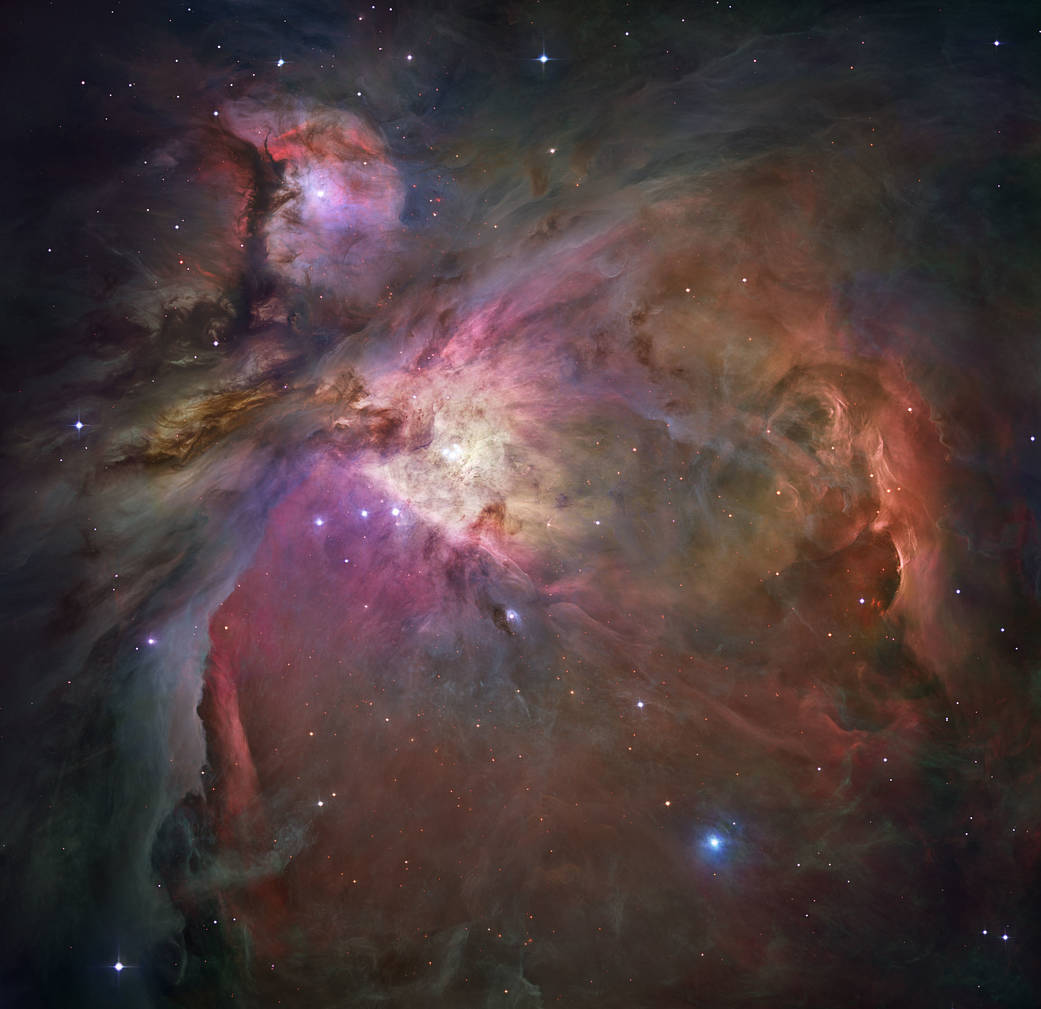This dramatic image from January 2006 offers a peek inside a cavern of roiling dust and gas where thousands of stars are forming. The image, taken by the Advanced Camera for Surveys (ACS) aboard the Hubble Space Telescope, represents the sharpest view ever taken of this region until this time, called the Orion Nebula. More than 3,000 stars of various sizes appear in this image. Some of them have never been seen in visible light. These stars reside in a dramatic dust-and-gas landscape of plateaus, mountains, and valleys that are reminiscent of the Grand Canyon.
The Orion Nebula is a picture book of star formation, from the massive, young stars that are shaping the nebula to the pillars of dense gas that may be the homes of budding stars. The bright central region is the home of the four heftiest stars in the nebula. The stars are called the Trapezium because they are arranged in a trapezoid pattern. Ultraviolet light unleashed by these stars is carving a cavity in the nebula and disrupting the growth of hundreds of smaller stars. Located near the Trapezium stars are stars still young enough to have disks of material encircling them. These disks are called protoplanetary disks or “proplyds” and are too small to see clearly in this image. The disks are the building blocks of solar systems.
The bright glow at upper left is from M43, a small region being shaped by a massive, young star’s ultraviolet light. Astronomers call the region a miniature Orion Nebula because only one star is sculpting the landscape. The Orion Nebula has four such stars. Next to M43 are dense, dark pillars of dust and gas that point toward the Trapezium. These pillars are resisting erosion from the Trapezium’s intense ultraviolet light. The glowing region on the right reveals arcs and bubbles formed when stellar winds – streams of charged particles ejected from the Trapezium stars – collide with material.
The faint red stars near the bottom are the myriad brown dwarfs that Hubble spied for the first time in the nebula in visible light. Sometimes called “failed stars,” brown dwarfs are cool objects that are too small to be ordinary stars because they cannot sustain nuclear fusion in their cores the way our Sun does. The dark red column, below, left, shows an illuminated edge of the cavity wall.
The Orion Nebula is 1,500 light-years away, the nearest star-forming region to Earth. Astronomers used 520 Hubble images, taken in five colors, to make this picture. They also added ground-based photos to fill out the nebula. The ACS mosaic covers approximately the apparent angular size of the full Moon.
The Orion observations were taken between 2004 and 2005.
Image Credit: NASA,ESA, M. Robberto (Space Telescope Science Institute/ESA) and the Hubble Space Telescope Orion Treasury Project Team
这张2006年1月的戏剧性图片提供了对一个由滚滚尘埃和气体组成的洞穴的窥视,那里有成千上万的恒星正在形成。这张图片是由哈勃太空望远镜上的高级勘测相机(ACS)拍摄的,代表了迄今为止对这个区域最清晰的观察,它被称为猎户座星云。超过3000颗不同大小的恒星出现在这张图片中。其中一些从来没有在可见光中被看到过。这些恒星位于高原、山脉和山谷的壮观的尘埃和气体景观中,让人联想到美国大峡谷。
猎户座星云是一本关于恒星形成的画册,从塑造星云的大量年轻恒星到可能是新生恒星家园的密集气体柱。明亮的中央区域是星云中四颗最重的恒星的家。这些恒星被称为 梯形,因为它们以梯形图案排列。这些恒星释放出的紫外线在星云中形成了一个空洞,破坏了数百颗较小恒星的生长。位于梯形区恒星附近的恒星还很年轻,有物质盘环绕着它们。这些盘子被称为原行星盘,由于太小,在这张图片中无法看清楚。
左上角的明亮光芒来自M43,这是一个由一颗巨大的年轻恒星紫外线形成的小区域。天文学家称这一区域为微型猎户座星云,因为只有一颗恒星在塑造这一景观。猎户座星云就有四颗这样的恒星。在M43旁边是密集的、黑暗的尘埃和气体柱,指向梯形区。这些柱子抵抗着梯形区强烈紫外线的侵蚀。右边的发光区域显示了当恒星风——从梯形区恒星喷射出的带电粒子流——与物质碰撞时形成的弧和气泡。
靠近底部的微弱红星是哈勃首次在星云中用可见光看到的无数褐矮星。褐矮星有时被称为 “失败的恒星”,它是一种太小而不能成为普通恒星的冷却天体,因为它们不能像我们的太阳那样在其核心维持核聚变。下图左边的暗红色柱子显示了空腔壁的一个被照亮的边缘。
猎户座星云距离地球1500光年,是离地球最近的恒星形成区。天文学家使用了520张哈勃望远镜拍摄的5种颜色的图片来制作这张照片。他们还添加了地面照片来填充星云。ACS镶嵌图覆盖的角度近似为满月的视角大小。
猎户座的观测是在2004年和2005年之间进行的。
影像来源:NASA,ESA, M. Robberto (Space Telescope Science Institute/ESA) and the Hubble Space Telescope Orion Treasury Project Team







